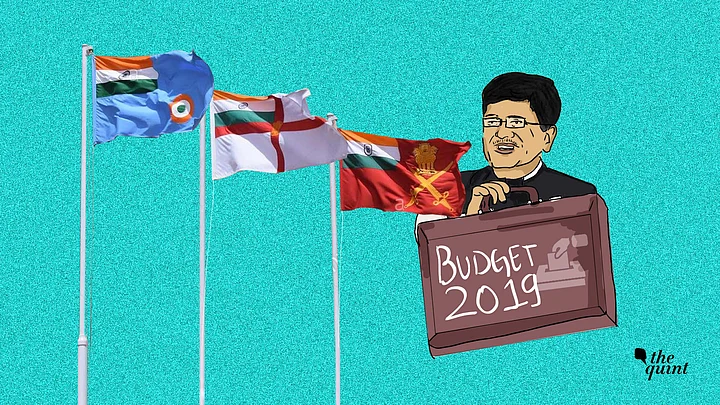The defence allocation for financial year 2019-20 has been pegged at Rs 3,05,296 crores as the budgetary estimate (BE) and this is estimated to be 1.6 percent of GDP.
The BE for the current fiscal is to be contrasted with the revised expenditure (RE) for defence in the FY 2018-19 which has been indicated as Rs 2,85,423 crores. In other words, the increased budgetary allocation for the current financial year is Rs 19,873 crores or a little under 7 percent from the RE of the previous year.
As a thumb-rule, to account for domestic inflation and the fluctuating exchange rate, a stand-still provision to maintain the Indian military by way of its pay and allowances; food and clothing; and training-cum-operational commitments (revenue expenditure) would call for an annual increase of 10 percent.
The 7 percent figure therefore is not an encouraging sign – but given that this budget is provisional – there may be a case for revision later in the year when a new government assumes office.
‘Manpower Intensive Nature Has Led to An Imbalance’
It has been repeatedly pointed out that the manpower intensive nature of the Indian military has led to an imbalance in the budgetary allocation for national security. Very broadly dis-aggregated, the Indian military has a revenue component – the standing costs indicated above; and a capital component that caters for the modernization and acquisition of major inventory and platforms such as tanks, ships, aircraft et al.
Ideally the capital component ought to be greater than the revenue or at the very least – the two heads should be near equal but this obtains only in militaries that are lean on manpower and more technology intensive.
In the Indian case, given the standing costs of a one million plus army, the desired revenue to capital ratio is 60:40 but this has been sliding to the detriment of capital allocation. In the BE for FY 2019-20, it is now projected as Rs. 1,03,380 crores – or a bit below 34 percent of the total defence allocation of Rs 3,05,296 crores.
However it is a slight improvement over the previous year, wherein for FY 2018-19, the revised capital expenditure of Rs 93,982 crores is the 33 percent of the total defence expenditure of Rs 2,85,423 crores.
‘Entire Capital Allocation Spent’
In an encouraging development – unlike previous years where the capital allocation would not be totally spent – the current budget figures reveal that the entire capital allocation of almost Rs 94,000 crores for the last year has been actually spent.
Defence Minister Sitharaman is to be commended for ensuring this level of financial utilization.
But this by itself is not an appropriate metric to assess the actual impact of such a level of capital allocation and disbursal. The inventory gaps for all the three armed forces are distressing.
The army is still awaiting induction of modern personal weapons and artillery guns; the air force has been crying hoarse for fighter aircraft and helicopters; the navy for ships, submarines and critical platforms such as mine-sweepers.
India does not (yet ) manufacture any major military platform or inventory item and hence the import bill is steadily increasing. The efficacy of the capital allocation is further shrunk in the global marketplace when we note that the rupee-US dollar rate has slid from Rs 64 to Rs 71 over the last 12 months.
Thus the capital allocation for the current FY will translate into lesser US dollars than what was the RE of the last year ( $14.56 bn and $14.68 bn) – and this is the intractable challenge to speedy modernization and acquisition of military inventory.
Thus, while the Finance Minister announced to audible cheer in parliament that the Indian defence allocation had crossed the rupees three lakh crore mark (under US $43 billion) – it needs to be appropriately contextualized for its actual impact on enhancing military capability.
‘Structural Challenge to Increase Total Allocation to 2 Percent’
The structural challenge is to increase total allocation to 2 percent of GDP and this can happen only if the national exchequer exudes greater vitality by way of revenue generation.
Within this increased allocation, the capital component has to be enhanced – and this cannot happen unless there is a steady reduction in the manpower of the army – the lead service.
And this in turn is unlikely to happen in the near future for the current composite security challenge (external and internal ) that India has to manage calls for the numbers that the army presently fields.
This a catch 22 situation and unless there is a radical review of what kind of a military machine India needs – and what it can actually afford, the current uneasy/unhappy status quo will prevail.
To the extent that the welfare of the man behind the gun is a critical indicator of the morale of the military as an institution – the issue of pensions and the expectation of one-rank/one-pension cannot be overlooked.
The current pension bill for the retired fraternity (including civilians paid by the Defence Ministry) is pegged at Rs 1,12,079 crores and this is greater than the total capital allocation by almost 10 k crores. And the pension bill will only increase – and cannot be grudged.
In summary – the outlook for modernizing the strait-jacketed Indian military is bleak due to severe fiscal strain – and is unlikely to improve in the near future.
